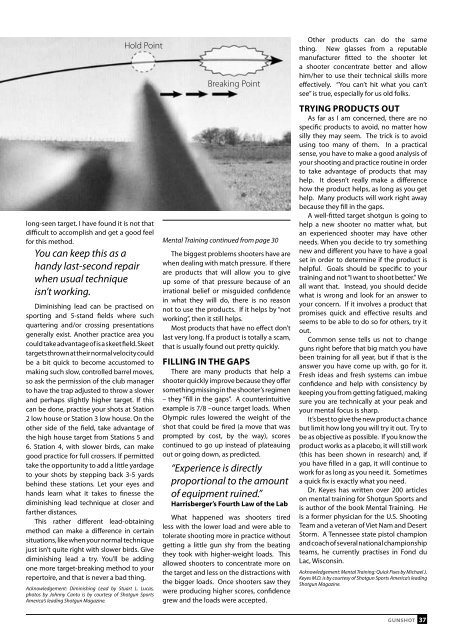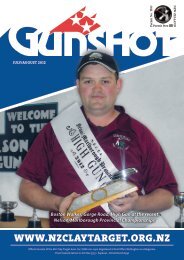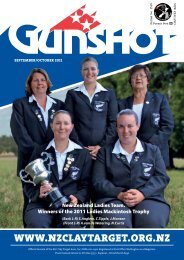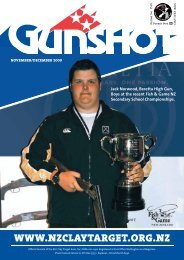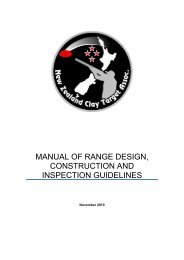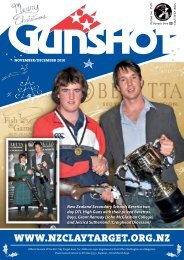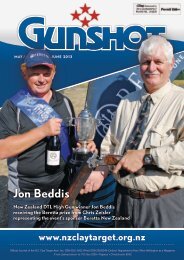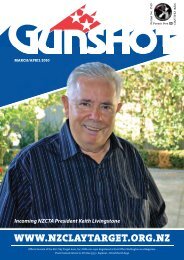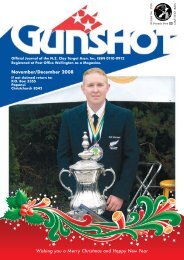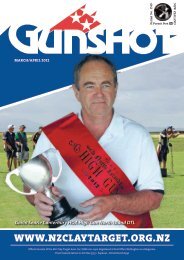July-August 2010 - New Zealand Clay Target Association
July-August 2010 - New Zealand Clay Target Association
July-August 2010 - New Zealand Clay Target Association
- No tags were found...
Create successful ePaper yourself
Turn your PDF publications into a flip-book with our unique Google optimized e-Paper software.
Hold Pointlong-seen target. I have found it is not thatdifficult to accomplish and get a good feelfor this method.You can keep this as ahandy last-second repairwhen usual techniqueisn’t working.Diminishing lead can be practised onsporting and 5-stand fields where suchquartering and/or crossing presentationsgenerally exist. Another practice area youcould take advantage of is a skeet field. Skeettargets thrown at their normal velocity couldbe a bit quick to become accustomed tomaking such slow, controlled barrel moves,so ask the permission of the club managerto have the trap adjusted to throw a slowerand perhaps slightly higher target. If thiscan be done, practise your shots at Station2 low house or Station 3 low house. On theother side of the field, take advantage ofthe high house target from Stations 5 and6. Station 4, with slower birds, can makegood practice for full crossers. If permittedtake the opportunity to add a little yardageto your shots by stepping back 3-5 yardsbehind these stations. Let your eyes andhands learn what it takes to finesse thediminishing lead technique at closer andfarther distances.This rather different lead-obtainingmethod can make a difference in certainsituations, like when your normal techniquejust isn’t quite right with slower birds. Givediminishing lead a try. You’ll be addingone more target-breaking method to yourrepertoire, and that is never a bad thing.Acknowledgement: Diminishing Lead by Stuart L. Lucas,photos by Johnny Cantu is by courtesy of Shotgun SportsAmerica’s leading Shotgun Magazine.Breaking PointMental Training continued from page 30The biggest problems shooters have arewhen dealing with match pressure. If thereare products that will allow you to giveup some of that pressure because of anirrational belief or misguided confidencein what they will do, there is no reasonnot to use the products. If it helps by “notworking”, then it still helps.Most products that have no effect don’tlast very long. If a product is totally a scam,that is usually found out pretty quickly.Filling in the GapsThere are many products that help ashooter quickly improve because they offersomething missing in the shooter’s regimen– they “fill in the gaps”. A counterintuitiveexample is 7/8 –ounce target loads. WhenOlympic rules lowered the weight of theshot that could be fired (a move that wasprompted by cost, by the way), scorescontinued to go up instead of plateauingout or going down, as predicted.“Experience is directlyproportional to the amountof equipment ruined.”Harrisberger’s Fourth Law of the LabWhat happened was shooters tiredless with the lower load and were able totolerate shooting more in practice withoutgetting a little gun shy from the beatingthey took with higher-weight loads. Thisallowed shooters to concentrate more onthe target and less on the distractions withthe bigger loads. Once shooters saw theywere producing higher scores, confidencegrew and the loads were accepted.Other products can do the samething. <strong>New</strong> glasses from a reputablemanufacturer fitted to the shooter leta shooter concentrate better and allowhim/her to use their technical skills moreeffectively. “You can’t hit what you can’tsee” is true, especially for us old folks.Trying Products OutAs far as I am concerned, there are nospecific products to avoid, no matter howsilly they may seem. The trick is to avoidusing too many of them. In a practicalsense, you have to make a good analysis ofyour shooting and practice routine in orderto take advantage of products that mayhelp. It doesn’t really make a differencehow the product helps, as long as you gethelp. Many products will work right awaybecause they fill in the gaps.A well-fitted target shotgun is going tohelp a new shooter no matter what, butan experienced shooter may have otherneeds. When you decide to try somethingnew and different you have to have a goalset in order to determine if the product ishelpful. Goals should be specific to yourtraining and not “I want to shoot better.” Weall want that. Instead, you should decidewhat is wrong and look for an answer toyour concern. If it involves a product thatpromises quick and effective results andseems to be able to do so for others, try itout.Common sense tells us not to changeguns right before that big match you havebeen training for all year, but if that is theanswer you have come up with, go for it.Fresh ideas and fresh systems can imbueconfidence and help with consistency bykeeping you from getting fatigued, makingsure you are technically at your peak andyour mental focus is sharp.It’s best to give the new product a chancebut limit how long you will try it out. Try tobe as objective as possible. If you know theproduct works as a placebo, it will still work(this has been shown in research) and, ifyou have filled in a gap, it will continue towork for as long as you need it. Sometimesa quick fix is exactly what you need.Dr. Keyes has written over 200 articleson mental training for Shotgun Sports andis author of the book Mental Training. Heis a former physician for the U.S. ShootingTeam and a veteran of Viet Nam and DesertStorm. A Tennessee state pistol championand coach of several national championshipteams, he currently practises in Fond duLac, Wisconsin.Acknowledgement: Mental Training: Quick Fixes by Michael J.Keyes M.D. is by courtesy of Shotgun Sports America’s leadingShotgun Magazine.gunshot 37


